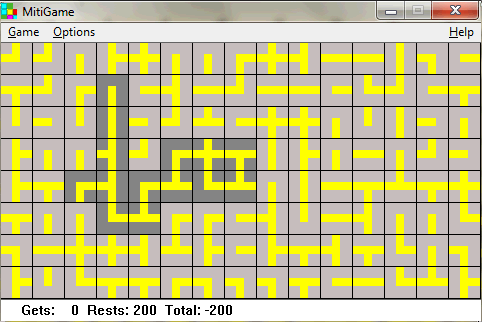



This particular addiction started in a time when computer magazines that had software extras, came with a 3-inch diskette rather than a CD-ROM. One of these diskettes contained shareware games for Windows 3, which I wasn't using at the time. When I finally did install Windows, the diskette pile was revisited and some games were installed. The only interesting game was the one where a tap has to be connected to a sinkhole by rapidly laying bits of pipe between them as they become available. There were straight pipes and "cross" pipes and bends in all direction. Each time I placed a pipe tile on the screen, the image of the next three new pipe shapes was shown, allowing me to plan three tiles ahead. And plan I did, putting bends in places where I thought I might need them and only hoping the game would supply me with the connecting straight pipes in time to finish; when the counter ran down to zero, the tap would open and a blue line of water would run down the route of pipe pieces, costing me a "life" if it spilled onto the field along the way. I usually made it on time, although sometimes I was still laying pieces when the tap was already running.
The fun ended after some time because it was a shareware game, so after 30 days I would have to pay for it or stop playing. So I stopped playing. Yes, I was green in those days.
There is a less stressful kind of pipe game where the pipe sections are already on the playfield and have to be rotated until everything is connected, with or without timer. Obviously, I prefer the second kind.
I was reminded of pipe games because they were used in several Oberon Media titles. Finding openSUSE a bit problematic when installing games, I looked for pipe games and found two to install under Linux Mint. The first struck me as too hard, so I tried the second, which is much more like that first pipe game under Windows. PipeNightDreams was a big disappointment. Firstly, the graphics are more like a DOS game than a crisp clear 16-bit Windows game. This was the "birthday edition" and had gaudy visuals, but even so I was squinting at the pipe pieces to see which shape they were. Secondly, to add to the DOS game feel, there is no dragging with the mouse. Each new tile is dumped onscreen in the form of an outline which has to be moved around with the cursor keys before anchoring it by pressing Enter. Thirdly and most importantly, the timer runs out after about 5 seconds! This is especially typical of DOS games: programmed on computers with old processors, they speed up so much on a faster machine that they become unplayable. (I don't know if this was a DOS game ported to Linux, or whether it is affected by processor speed, or just made by sadistic programmers.) Lastly, although it hardly matters compared to the previous three reasons: what comes out of the tap is not blue water, but green goop.

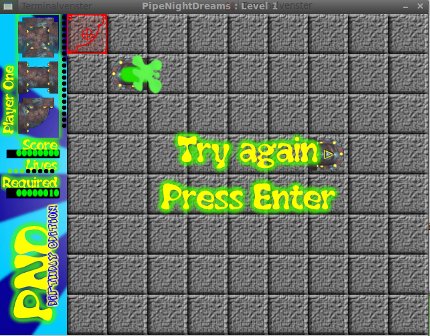
Arghh! No time to place even one tile!
Disappointed, I turned to the other game, PipeWalker, which at least didn't have a timer. Here, the pipe bits have already been laid out, and it is for me to rotate them until all terminal screens are connected by pipes to the server. The terminals tend to be clustered together, and at first I thought the games were unsolvable, until I found that the pipes "wrap around": a pipe running offscreen on the right can be connected to a ditto pipe on the left, and it also works from top to bottom. I also found that generally every piece of pipe has a function, no matter how uselessly it seems to be placed, although just occasionally I'm left with an unconnected piece of pipe - was I smarter than the programmers, or did they throw in the occasional unnecessary piece to keep the players on their toes? When all terminals are connected and the pipes are blue to show that they have a connection to the server, the screens throw stars until the player clicks on the arrow button to go to the next level.
I played version 0.7.2 of the Linux port, but a websearch turned up a link to the PipeWalker homepage which has higher versions (upwards of 0.8) for Windows, which are said to be skinnable.
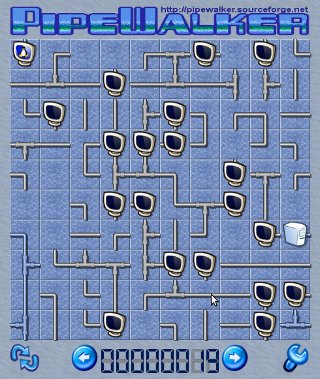
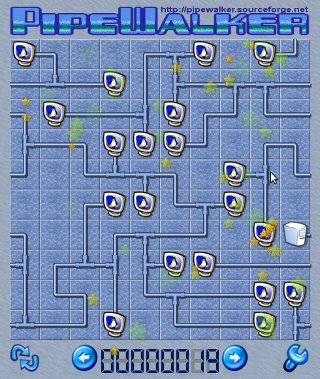
The game after the first few moves, and its triumphant ending.
OpenSUSE 13.1 still has that same port, and a few other games in this category too: the very similar KNetWalk and QNetWalk. As can be expected from a program whose name starts with a K, KNetWalk has themes, sound effects, a resizable window, a number of different game settings including "Custom" which allows the player to set the number of squares in the board, and a "Solution" button for when a puzzle seems just too hard. No stars jump off the monitors when the user solves the puzzle, though. QNetWalk has four difficulty settings, and that's it. Either game freaks me out just a little because the mainframe has more than one connection.
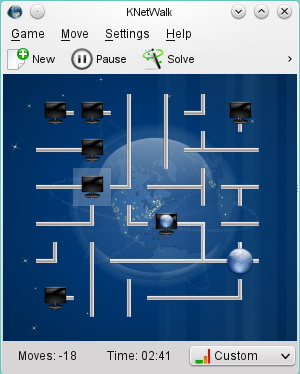
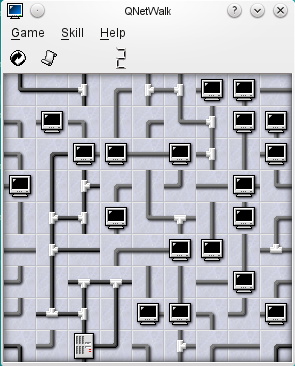
Elaborate versus simple, same format.
The same distro also has a game close to that first Windows pipewalker: Vodovod, which I found too frustrating to play, but am including for the sake of completeness. Click on the graphic to see a bigger screenshot.
Lastly, on a half-related note, MaciGame has two game modes: SameGame proper, and MitiGame, where the string of tiles to be clicked away is not determined by whether the tiles have the same graphic, but whether their graphics connect at the edges: a more difficult pipewalker/samegame hybrid, that uses a different (but still skinnable) type of tileset.
